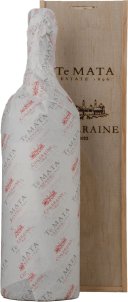Chateau Rauzan-Segla 2me cru classe
One of the original Second Growths of the Bordeaux Classification of 1855, Rauzan-Ségla's 51 hectares of mineral rich soils begin on the banks of the Gironde, on the left bank of Bordeaux. A complex mix of gravel, clay and limestone subsoil imparts a richness and complexity to the Cabernet (62%), Merlot (36%), Cabernet Franc (1%) and Petit Verdot (1%) grapes used to produce this powerfully intense and elegant wine. The estate was last sold in 1994 to the Wertheimer family of Chanel, who employed former Château Latour winemakers, David Orr and John Kolasa. Nicolas Audebert, the former winemaker at Cheval des Andes, the LVMH property in Mendoza Argentina, was hired to succeed John Kolasa following his retirement in 2014.
Chateau Phelan-Segur
Te Mata Estate Coleraine Cabernet Merlot
Te Matas Hawkes Bay estate is a prestigious winery with a rich history, producing some of New Zealands most celebrated wines. If the Langtons Classification crossed the Tasman, Te Mata Coleraine would sit alongside Grange at its very pinnacle. Established, esteemed, outstanding vintage after vintage, the glowing adjectives come thick and fast.
Chateau d'Issan 3me cru classe
Chateau Du Tertre 5me cru classe
With a history dating back to 1143, Chateau du Tertre is one of the oldest properties in Bordeaux. Since 1995 it has been in the hands of the Jelgersma family, also owners of Chateau Giscours. The du Tertre vineyard is a large single block, with 52ha under vine, planted to Cabernet Sauvignon (55%), Merlot (27%), Cabernet Franc (11%) and Petit Verdot (7%). Biodynamic viticultural techniques were being introduced beginning in 2008 and du Tertre was one of the first in Bordeaux to ferment grapes in egg-shaped concrete vats. The property produces a second wine, Les Hauts de Tertre, and from 2014 a dry white wine, Tertre Blanc, an unusual blend of Sauvignon Blanc, Chardonnay, Viognier and Gros Manseng. This Margaux property was classified Cinquieme Cru (Fifth Growth) in 1855.
Tenuta Dell'ornellaia Le Serre Nuove
Chateau Branaire-Ducru 4me cru classe
Chateau Branaire-Ducru is a fourth growth (4ème Cru Classé) St-Julien estate, in the southern area of the appellation. The Grand Vin has a high proportion of Cabernet Sauvignon between 80-85% in most years; one of the highest in the Médoc. The grapes are hand-harvested and undergo a three week post fermentation maceration to build tannin structure before the wine is matured in 60-65% new French oak barriques for 16-20 months. Branaire-Ducru is renowned for producing classic claret wines that are elegant, ripe and well balanced.
Domaine de Chevalier Rouge Grand cru classe
Chateau Duhart-Milon-ROTHSCHILD 4me cru classe
Chateau Duhart-Milon is a fourth growth (Quatrième Cru Classé) estate in the Pauillac appellation of Bordeaux. Part of the Domaines Barons de Rothschild, the wine is made by the same winemaking team as Chateau Lafite. A blend of Cabernet Sauvignon with a substantial component of Merlot, the Grand Vin is matured for 18 months in approximately 50% new French oak barriques. Chateau Duhart-Milon is typically a sturdy solid Pauillac with firm structure and earthy savoury richness.
Domaine A Cabernet Sauvignon, Coal River Valley Tasmania
Domaine A Cabernet Sauvignon, which also includes a small percentage of Merlot, Cabernet Franc and Petit Verdot is a foil to the more opulent mainland styles. Violets, roses and blackcurrants pervade through the wine like an English country garden. The tannins are especially fine grained and there is a beautiful freshness and mineral quality on the palate. The parcels of fruit are batch vinified in stainless steel tanks before maturation in 100% new oak for between two and three years.














